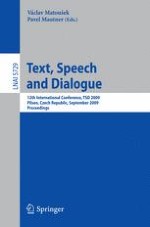2009 | Buch
Text, Speech and Dialogue
12th International Conference, TSD 2009, Pilsen, Czech Republic, September 13-17, 2009. Proceedings
herausgegeben von: Václav Matoušek, Pavel Mautner
Verlag: Springer Berlin Heidelberg
Buchreihe : Lecture Notes in Computer Science
